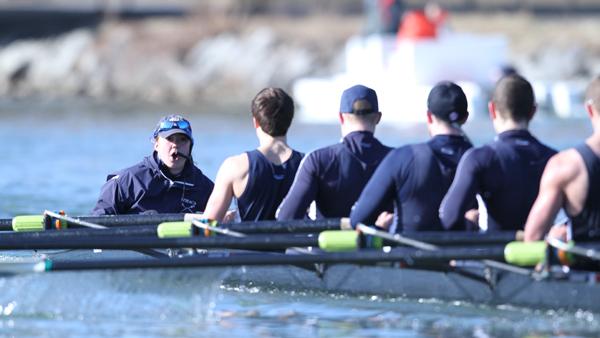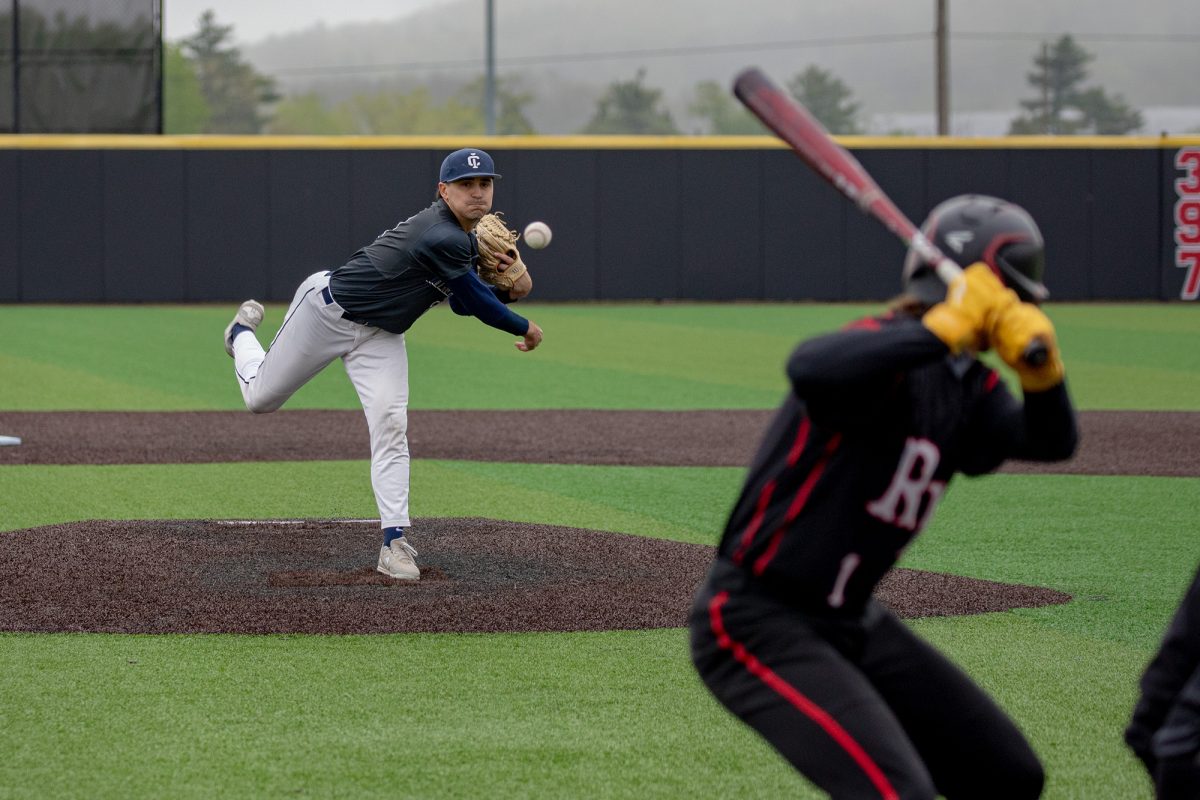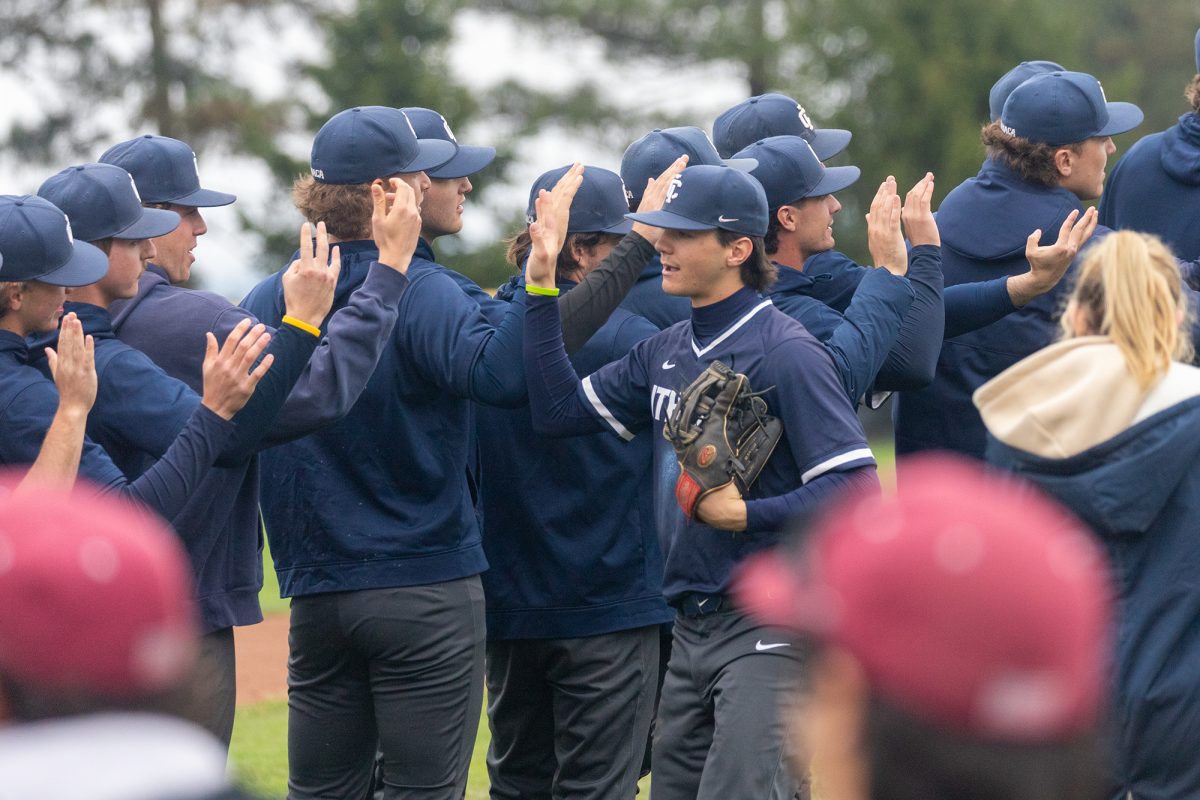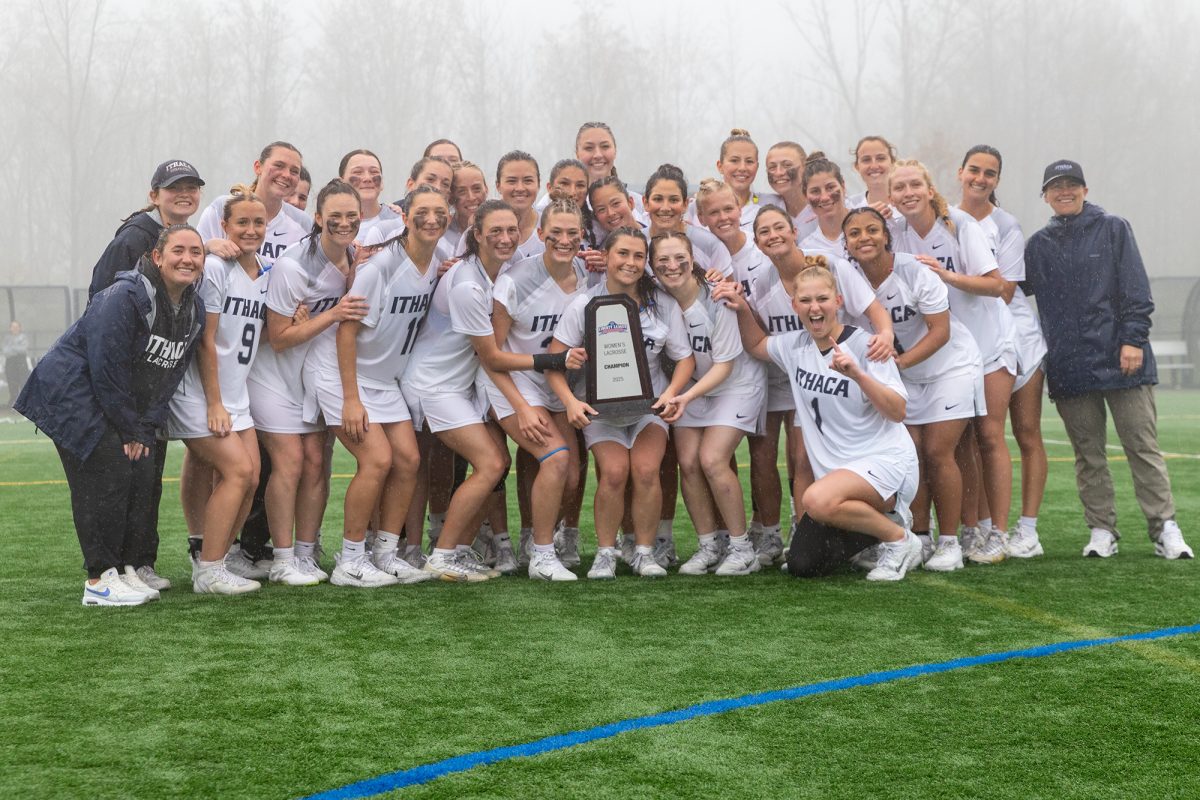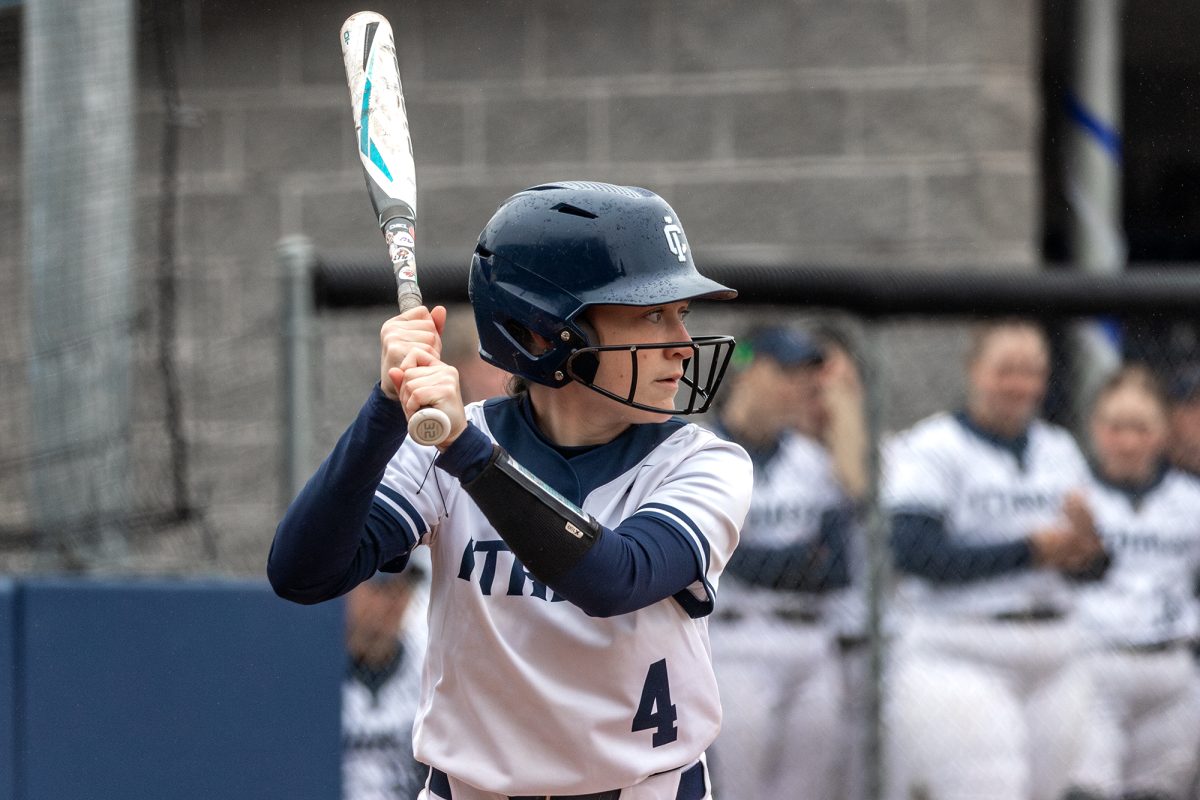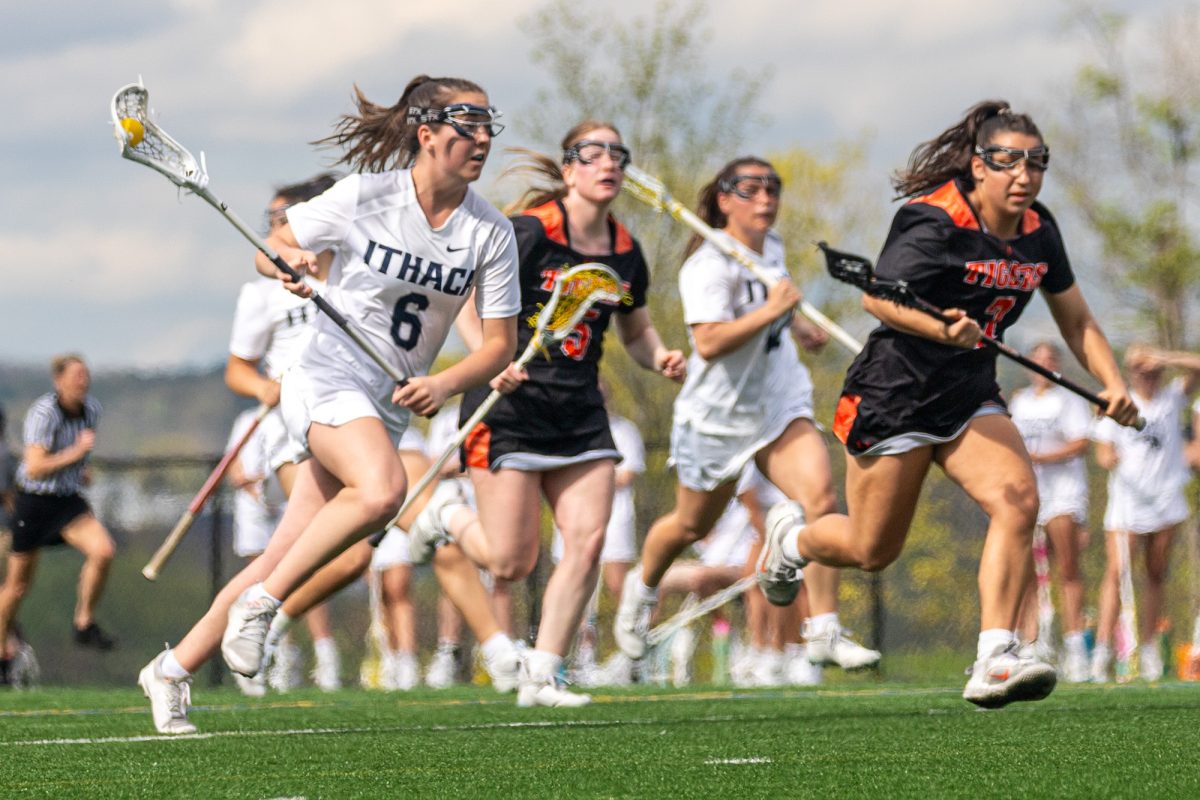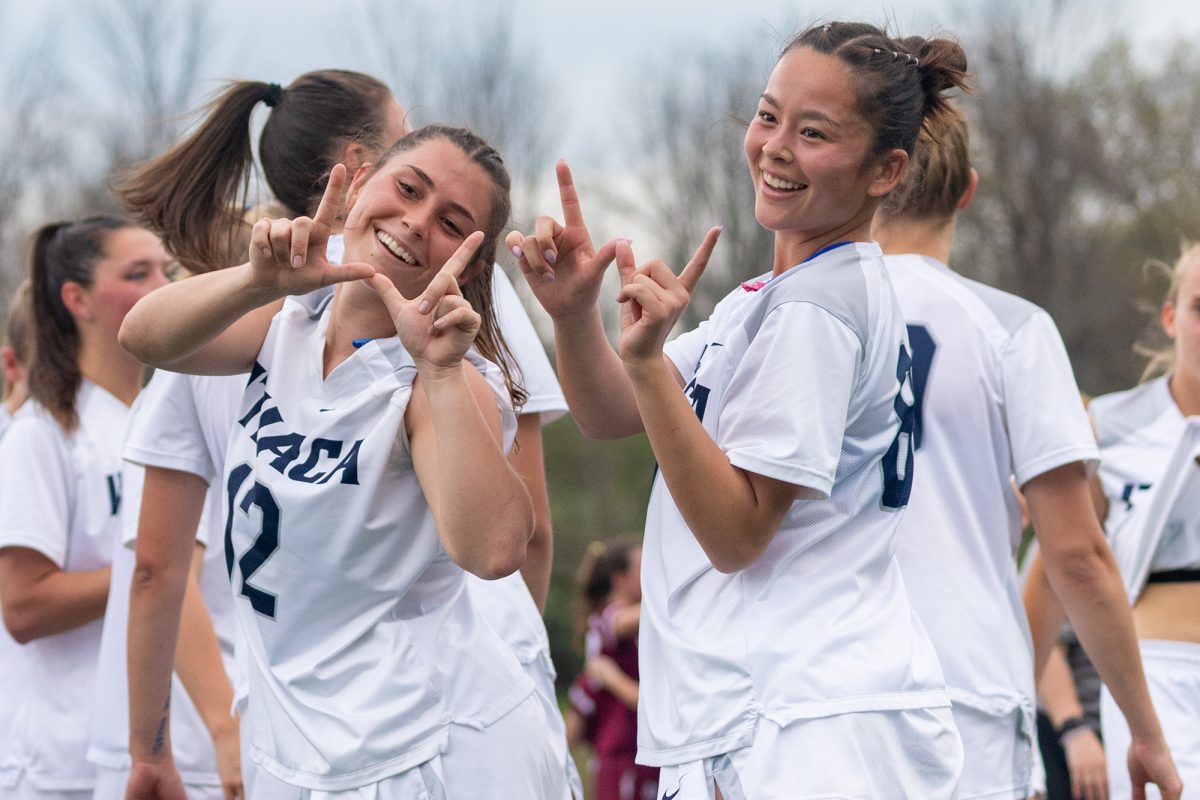The sun is at its highest point in the sky and the water on the Cayuga Inlet is still as the Bombers’ crew team readies itself for its first home race of the season. Senior coxswain Rachel Jordan calls her eight rowers into their boat for the race, getting them in place for a matchup against rival Hobart College. Jordan sits at the back of the boat facing forward, and the eight men in the boat sit in a line facing toward her.
“One foot in,” she calls as she and her teammates put a foot in the shell. The other foot follows shortly after.
All eight rowers stoop, hands on the side of the boat, anxiously awaiting Jordan’s next call.
“Shove in two,” Jordan calls. “One, two, shove.”
On two, the boat glides away from the dock as the nine in the boat take their seats simultaneously. When Jordan makes a call, her teammates listen and respond.
She raises her hand in the air, calling her teammates in the bow of the boat to take small strokes to align the boat properly while the rowers ready themselves for about seven minutes of physical exertion.
“Sit ready,” she tells her team dropping her hand, as her teammates move forward and place their oars in the water, ready to take the starting stroke.
The official calls for the start, and the rowers release their first five strokes full of pure adrenaline. Jordan’s teammates push through the initial stretch of the race, and it is her responsibility to ease them into race pace. She makes a call when her teammates’ oars should be hitting the water.
“One,” she calls as the oars break the plane and lift up out of the water once again.
“Two,” she shouts as all eight oars cut through the surface in synchronicity.
As a coxswain, Jordan acts as the eyes of her teammates. If a rower turns their head, they can offset the balance of the boat. She also serves as the motivation the rowers need when they are beginning to get exhausted around 1,500 meters into a race. She is the one who tells her teammates where other school’s boats are in relation to theirs and breathes life into a tired squad.
The boat needs Jordan to keep on pace, and she needs all of her rowers to be in synch to move the boat at the demanding pace at which varsity crew boats need to row. She is a varsity athlete, but not a typical one. She is a part of the men’s varsity crew and one of two female athletes on male intercollegiate teams at Ithaca College, both in the crew program.
Though opportunities have grown for women in athletics over the past few decades, few female athletes compete on male teams. Through cooperative efforts between the men’s and women’s crew teams, female athletes like Jordan have had an opportunity to take part in male athletics and have found that, when given a chance, the difference between men and women is less important than the shared drive to win.
In 1972, Title IX was passed into law. This decree has given women an opportunity to compete on a more equal scale. The legislation’s three-pronged law states that schools have to meet one of three criteria in order to meet Title IX’s standards, one of which states that schooling systems have to present both men and women the same opportunity to participate in sports and allow them to have competitive athletic schedules.
The Bombers’ men’s crew team, as well as other crew programs like Hobart College and Cornell University, has complied with Title IX by incorporating female coxswains into men’s boats. Stephen Mosher, professor of sports management and media, said this trend is growing. It is a common occurrence in college crew, but not all programs promote this intermingling.
Mosher said an unwillingness to allow women into men’s boats is a result of these outdated perceptions of male dominance in sports, even though a woman could be just as good, if not better, at the sport. In crew, women generally act as the coxswain if they are on men’s teams. Mosher said most women have a lighter weight that helps the boats move faster. Because of this, he said it makes strategic sense for men’s boats to use female coxswains.
“We still live in a society that’s uncomfortable with the two genders participating in the same sporting activity, even though in crew it’s quite obvious that the coxswain needs to be a smaller person,” Mosher said. “It’s also true that, on average, females have a much better sense of timing than do men, and so you have a larger pool of people you can pick from to find somebody who is excellent.”
Freshman Kristen Handal joined the college’s crew team this fall as a coxswain for the women’s team. The novice men’s team was in need of a coxswain, and Handal volunteered to switch teams and go where she was needed most.
Handal said initially the switch was a little scary, but she has already gotten used to her new environment and teammates.
“At first it was weird, because I felt like I was the only girl, but it’s better now, because I feel like I’m really part of the team,” she said. “I don’t feel like I’m by myself anymore.”
A three-year veteran coxswain, Jordan rowed for the women’s team her freshman year at the college but had to quit rowing because of injury. Like Handal, Jordan volunteered to become a part of the men’s boat, where she had to learn a completely new set of skills to transition from being a rower to a coxswain for a boat full of men.
She said initially the new environment frightened her, not because she was a singular female on a men’s team, but because she had no idea how to cox. She said her teammates were supportive from the start and made the learning experience less difficult and gave her a more well-rounded view of male athletes.
“People from the outside looking in always ask me, you know, because the guys are all in really good shape, they ask me ‘How do you deal with these guys shirtless all the time?’” Jordan said. “Honestly, I don’t even notice it. That’s just how they row, and they’re my teammates, not anything more than that.”
Sophomore Charlie Enright, who had not rowed before joining the men’s crew, said he never heard that female coxswains were participants on men’s teams before joining the team. He said when he first got in a boat with a female coxswain, it took some getting used to, but today, the gender of the leader of his boat has no effect on the way he rows.
“There are noticeable differences between coxswains, but they’re not differences that are a factor of gender,” Enright said, “The only discrepancies between coxswains are over how they cox.”
Enright said that positive rower-coxswain relationships are formed based on trust between members, built over time. A good coxswain commands authority and skill in the boat, and many can effectively act as a coach to help with rower’s mechanics during practice, which can ultimately lead to success in races.
“Once you have built a healthy relationship with your team, there’s a really, really strong bond,” Enright said. “I feel like it’s easy to get that guy-to-guy and girl-to-girl, but when there’s a bond and trust between a women’s coxswain and men’s rowers, it shows a really strong relationship.”
Some critics of the co-ed varsity athletics have argued that gender dynamics between men and women would create an unfair situation, where the men would feel uncomfortable having a female teammate and treat her differently. Handel said she has found that her teammates treat her just like anyone else on the crew team and has created friendships on the team.
“They talk about boys stuff when I’m right there,” Handel said. “You know, they don’t really have a special filter.”
Both Jordan and Handel said they have formed positive relationships with their male teammates that have benefitted them on and off the water, showing them that men and women can work together in sport.
Mosher said the integration of women onto men’s crew teams seems to be a clear sign that the idea that the masculine world of sports has gradually shifted over the past few centuries.
“Well I would think that if you looked 100 years ago, you wouldn’t see any female coxswains, and 100 years ago you wouldn’t see any girls playing on modified or high school basketball teams, and I think it’s clear that things have changed,” Mosher said.
The men’s and women’s crew teams are the only varsity sports on campus that have incorporated both genders onto a single team. While many sports, like basketball and track, compete with similar rules in each gender’s sporting division, none but crew have allowed men and women to compete together. Mosher said he thinks the crew team is ahead of the curve and can see the landscape of sports heading into that direction.
“Society has moved tremendously in the past 50 years, certainly since Title IX became a method for women and girls to gain access to sport participation, that it’s just a matter of time for sporting organizations to include women at every level,” Mosher said.


